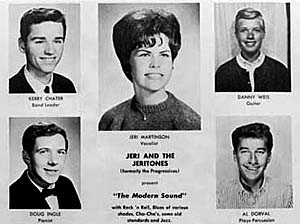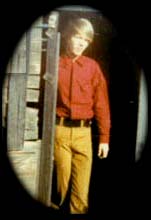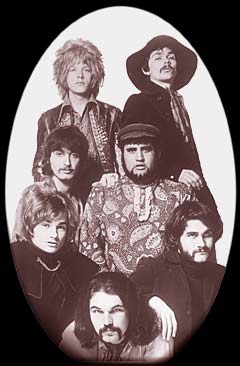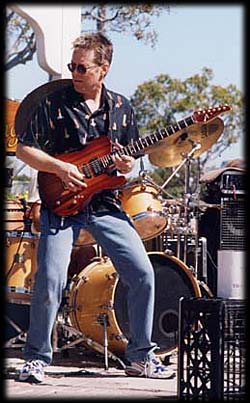|
|
 |
 |
talking to Nick Warburton
in June 2001
|
|

You were born in Los Angeles and brought up in San Diego, how old were you when you first started playing guitar and who inspired you?
I was born in Huntington Park in the Los Angeles area, and I started playing guitar at 12... there wasn't any one specific person that inspired me, my father was a very good jazz guitar player, he died when I was 16, but he showed me a lot, got me started, told me that he wanted me to learn the basics, a few songs, chords, how to hold the pick, basic forms etc, and he wanted me to learn myself and to develop my own style, not to sound like anybody else....
I found myself phrasing my leads off of saxophonists like Junior Walker and King Curtis, I listened to a lot of drummers, and also keyboardists like Billy Preston, Chester Thompson, Richard Tee, some of the clavinet stuff you'd hear on the Isley Bros albums... as for guitar players, I started on the guitar learning a whole bunch of songs by the Ventures at the age of 12... it was just something to get started with.
What were the first groups you played in?
The very first group I was in was called The Shados... that was at the age of 13, then the next one was The Progressives, alias Jeri and the Jerritones and then most of that band went on to form a band called The Palace Pages, because we played at a place called the Palace in San Diego, and then part of that band went on to be the Iron Butterfly.
 |
Jeri and the Jeritones
(formerly The Progressives)
clockwise from top left: Kerry Chater, Jeri Martinson,
Danny Weis, Al Dorval, Doug Ingle
This picture and the one below of Danny in 1966, courtesy of Rick Gagnon.
|

Could you tell us a bit about your time with The Iron Butterfly. It seems the original group never really fulfilled its potential as a band.
 |
| Danny Weis in 1966 |
 |
Iron Butterfly 'Heavy' 1968
|
No, it didn't... actually what happened was that we did the very first album which was called Heavy, and there was some internal dissension amongst band members, and because of internal tensions I became disillusioned and unhappy with the constant bickering and headbutting about the way things were being done... and right after the first album, I left the band and Jerry Penrod the bass player and Darryl DeLoach, one of the singers, also left at the same time. Erik Braunn replaced me in Iron Butterfly, and if I remember correctly, he bought a lot of my equipment, some of my clothes, they tried to clone me basically... and then In-A-Gadda-Da-Vida came out on the second album and that's when the band became really successful, that was a huge single, which of course made the first album sell, and I eventually made some money off the first album as I wrote or co-wrote about half of that... so to answer your question... full potential as the original band? .. no, were it have gone farther and gotten bigger had I have stayed? God only knows.
It's strange, there was an interview in April's Rolling Stone magazine with Ahmet Ertegun about his book about Atlantic Records and he said... 'There were a lot of rock and roll bands playing clubs on the sunset strip so one day I asked Dewey Martin the drummer with Buffalo Springfield which in his view was the really hot new band. Dewey told me, 'there's a band called Iron Butterfly which I think is great, they've got a fantastic guitar player'. That guitarist Danny Weis was creating a big buzz so I went to see the band and they were terrific'. He went on to say that when he went to see the band to hear songs for the second album he got to the rehearsal and it was a totally different band, and he asked, what happened to the guitar player? and they said, 'Oh, he quit right after we made the first record!' (to read this article, see the link at the bottom of this page)
Also...to clear one thing up, I didn't play on In-A-Gadda-Da-Vida, it was nothing to do with me, and I don't like it much either.

From reading articles about that period, you seemed to have attracted a lot of attention and respect from other musicians... I read in the Al Kooper book that David Crosby was really into your playing... and that he (Al) once approached you about joining one of the first versions of Blood, Sweat and Tears .... What truth is there in all this and who else did you play with in that period?
I remember Al and David Clayton Thomas and Bobby Colomby the drummer, they were all cool.. At that time in my life I played with a lot of different people, there was so much going on, we were all having a good time, partying and playing as much as possible with whoever. It was a great period... what a wonderful time to become successful for musicians! One didn't have to fit a mould, one could just be good and be any style, I mean I remember playing with maybe five different bands on the same night and they were all doing good things, all different kinds of music all combined together, and everybody was happy with it.. forget the specifics... all I can tell you is that I did a lot of different things with a lot of different people.

What was your initial impression of the whole Rhinoceros setup, did Paul Rothchild tell you what kind of style he wanted you as a band to play, or did you have to find your own way as the group developed?
 |
| Rhinoceros 1969 with Danny Weis (top left) |
The whole concept he had and the label had was for it to be a Supergroup, and at one time I think it was even gonna be called Supergroup... and another name he came up with was Mach 7, I remember one day he got the whole band together, and had it up on the easel... a big dramatic thing, and he unveiled it, you know, pulled the cloth off this name, and the looks on everyone's faces in the band was like...completely blank... it was like.. 'Oh'!
Musically, I don't recall that we were asked to play in a specific style, I think everyone was able to be themselves, and there were a lot of songwriters in various different styles, we didn't put the band together... we were put together. John Finley had a strong writing style, and so did Alan Gerber, I was coming from psychedelia and flash rock to this group of people that seemed to be going more in the direction of rhythm and blues. Prior to the Iron Butterfly I had played a lot of rhythm and blues stuff, I had played a lot of what they call casuals here in Los Angeles, that's another name for private parties, weddings, anything that isn't like a club or unspecific... we played a lot of naval bases, marine bases in the San Diego area which was a real military town and I got into a lot of R&B stuff... y'know James Brown, Isley Bros, Junior Walker and all the people that were happening in that area... so when the Rhinoceros style kind of developed that way I was right into it.
On that first Rhino album you and Doug seemed to have a great empathy between you and your guitar styles really worked well together, did you feel that you both had a similar approach?
That was an interesting combination, normally I don't like playing with other guitar players, not because I'm on any kind of ego trip at all. I always respect great players, but because most of the time I'm very aggressive with my playing and guitar players generally have a tendency to fill in the same spot and so there's always a lot of stepping on toes and when there's two or more guitar players in the same band that are equally aggressive, but Doug and I complimented each other, we didn't have to work on it that much, apart from deciding who would play which part or who would play lines or whatever. He had a style that was much like Michael Fonfara did on keyboards, for instance Michael would always play a rhythmic mirror image of what I played and so where my spaces were is where Michael would be, and that worked so well. That also happened with Doug, we learned to play off of each other, and I think we developed a good way of playing together... his guitar style wasn't really much like mine although we actually came up with new styles whilst in Rhinoceros, for instance, the chicken pickin style, I'll call it... it was in Apricot Brandy and most of the other songs... kinda like...(sings 'bada-bada-bada-bada-da-da' sounding like one of his licks from the first album!)... you know, that Chicken Pickin shit all over it... there's a lot of that all over Rhinoceros.
Yeh, that's such an original thing about the Rhino stuff...
Prior to Rhinoceros I didn't do that, and what I attribute that to was when I was really young my Dad, even though he was a jazz guitar player, played with a lot of people that were in the country circuit and western swing was real big... there was more money in it to support the family... and he backed a lot of people from the Grand Ole Opry, so from age 5 to age 12, I used to go to this place called Bostonia Ballroom in El Cajon California and I would listen to these tremendously talented Grand Ole Opry acts, and I remember being fascinated with pedal steel guitar and I would be only about 3 or 4 feet high, so my head would be leaning on the stage and I'd be just staring at these steel guitar players and I just loved it, but I didn't even play guitar in those days, and when I was around 16 or 17 and when I got into Rhinoceros I started remembering that technique of right hand picking that pedal steel players and country guitar players have, and it just started coming out in Rhinoceros. It's funny how your mind retains stuff like that, you just have to tap into it, and so all those licks and styles where in my memory banks somewhere and for some reason they decided to come out in Rhinoceros, and Doug picked up on it, and the band liked it, and we started developing a style based around that type of feel.. duh, duh, du-ahh... there's that track 'Chicken' on the second album, it's chicken pickin, that's what they call it.
It seems that you played the more 'out-front' guitar style on the albums, and Doug was more laid back in his approach...
Well actually, Doug and I had very different styles, I was always the more aggressive player if you like, but we did play together well, our styles complimented each other... and when Doug left and Larry Leishman joined, he was good to play with as well. It's a matter of guitar etiquette, if you're prepared to give, and listen to the other guy, you can make two guitars sound really cool, you have to have some mutual respect.
Who, for instance did what on 'Apricot Brandy'?
The fills were all Doug, I played the main riff part of it, and the lead line horn riff was Michael's contribution to the song. 'Apricot Brandy' seems to really stick out with a lot of people, in fact it's still being used for various things, on the radio, on TV shows for background music and I'm still getting royalty checks for it... not big, but it's still being used. Also, Michael Fonfara has done a version with two Hammond B3 players, which I haven't heard yet.... I know Danny Gaton did it too, but I've not heard his version either... God rest his soul.
|
John Haeny said that you used Fender guitars and fender twins, tell me a bit more about the equipment you were using in Rhinoceros, did you use any pedals to get that great sustain?
I used Telecasters, On the first Rhino album I had an early '50s Telecaster. For amplification, I used a '59 Fender tweed Bassman with 4 ten inch Jenson speakers, they were blue, like the solo for instance on 'Belbeukus', what a great tone, I don't get that tone these days, but I don't have that particular set-up... that's just a bassman with every knob turned up as far as it'll go, and the guitar turned up as far as it'll go, and that amp just naturally overdrives and sings very nicely, it's a great lead tone, it wasn't very loud, I think it was only 40 watts.
There was a wonderful guitar player who is still in the Los Angeles area who mainly does a lot of teaching, and his name is Ted Green, and he is one of the finest guitar players on the planet as far as I'm concerned... and Ted at that time was like a wizard, he was so into guitars and their electronics and he used to modify them, I'm not sure whether it was the first or second album, but he took my stock Telecaster which came with two pickups, and put three Stratocaster pickups on it, made a special pick guard that would accommodate that middle pick up, and he also added other electronics as in out of phase switches, what they now call a varitone, so it was anything but stock, and he did the same with Doug's Telecaster which was a black one, mine was blond.
Besides the Bassmans, we also used Fender Super Reverbs, which were very much like bassmans in that they had 4 tens, but they had reverb. In Rhinoceros at one point I had three Fender Bassmans and one Super Reverb, and I used all four amps, two on each side of the stage, they weren't that loud 'cos they were only like 40 watts each, but the sound was full. I don't remember using any effects at all in Rhinoceros, but if I did, one of my favourite effects would be Echoplex, so I may have used one of those. I haven't used one for a while, because my last three Echoplexes died, but I hear that someone is making them again. As far as I know there were no overdrive pedals at that time, I just used my little pinky finger, I had everything turned all the way up... I think those amps actually went up to 12! ... and I used to turn up the guitar for leads, and back down for rhythm, as simple as that.
I kind of miss it, there's a real freedom without being tied to a pedal board, and there's no duplicating that sort of tone without doing it that way, with that equipment.
When we were doing the third album, 'Better Times are Coming', Larry Leishman and I got some Marshall amps that had come out, they were 50w combos and we both used two, I had one with 2 X 12s and one with 4 X 10s and I used them both with a Y chord, I'm pretty sure I was into using the Echoplex at that point, Larry was using a similar set up, we got them from Sam Ash music store in New York City.
Anyone that saw Rhinoceros live says that you were really powerful on stage, why do you think the second and third albums didn't capture the raw sound of the band as much as the first one?
On the second album, there was a different engineer, John Haeny didn't do it for some reason, there was also a different bass player, Peter Hodgson came into the band. We recorded at the same studio and were using the same basic instruments, but things had already changed. There are a few things on there that we thought were funny and gimmicky at the time, but looking back, it was kinda silly, but there were also a few good songs on there. I really like 'Top Of The Ladder', but I think overall there were better songs on the first album. It's strange that the band didn't sound so energetic on the second album, because the band was always extremely energetic on stage, right through to the end and 'Better Times Are Comin', which of course was ironic, cos they weren't.. it was on it's way out!
The third album was produced by Guy Draper, who in retrospect I was not so happy with, we even did some of his songs on that album. There was a lot of internal arguing and stuff, and really Rhinoceros was dying at that point... we were young and we had different opinions on things.

When you left Rhinoceros, you worked with the Rascals for a short time, and then got back with Blackstone, and then you did session work for people like Lou Reed, and Ian Matthews, can you tell us a bit about that session period?
Well..I replaced Buzzy Feiton in the Rascals and then after a while he replaced me when I had other things on and couldn't do it. He was a great guitar player, and we're still friends, we have always had a mutual respect.
Blackstone was an attempt to re-capture some of the fun we had in Rhinoceros, and it was pretty short lived.
The Lou Reed part of my life... I've got to give thanks really to Prakash John who got me the call with Lou Reed. Prakash also played with Blackstone for a while at the end. I did the 'Sally Can't Dance' album along with the tour that followed, which was rather a long tour of Europe, Australia, New Zealand and the United States. He also got Michael Fonfara in there too. Peter Hodgson also did some of the tour. That was a great band. After the Lou Reed stuff, I filled in with Alice Cooper for a short period, when his guitar player was unable to do some shows, and that was an amazing visual show, with props and monsters and stuff, it really was something.
Also you and Michael played on Alan Gerber's solo album?
Yes that was good too, Alan's always been a very cool guy.
What did you do in the eighties?
I moved to Canada around 1980, I did an album with a band called 'The Lincolns' but apart from that I didn't find there was much going on there and so I came back here to LA in 1983. When I first moved back I stayed with friends whilst I did a lot of songwriting and played with some local bands, clubs, that kind of thing. I was approached do to a new version of the Electric Flag with Harvey Brooks and Mike Finegan on keys, but not Buddy Miles, but it didn't come to much... actually Paul Rothchild put me in touch with that. Also there was a band called Workforce that had the same singer and bass player as Funk Attack, Ron Green and Jim King. I also did some country gigs.

Tell me about what you're doing these days?
 |
| Playing with The Danny Weis Project |
These days, I'm musical director for a church called Arise Christian Center in the Los Angeles area, and it's a predominately Afro-American church, it's mostly rhythm and blues and the pastor has given me a lot of freedom to create on the spot, that for me is spiritually and musically very rewarding. I have some of L.A's finest musicians playing in this church and I'm very fortunate to have them in the band.
Then there's the band I put together about 14 years ago; Funk Attack. I left the band at one point thinking I was only going to play Christian music and the guys in the band continued with Willie Ornelas becoming the leader, and although my beliefs are still the same, I found that I missed it, so after a year I went back into the band, so now I'm in Willie's band, at least that's how he likes to think of it,
ahahaha! They are a great bunch of musicians, the line up these days is: Willie Ornelas on drums, Ron Green on vocals, Jim King on bass, Vince Denham on sax, Lee Thornberg or Roy Wiegand on Trumpet, me on guitar and occasionally we use Ruben Valtierra-Keyboards. We work quite a bit in the Los Angeles area.
I also have a thing going called the Danny Weis Project which I put together about three years ago, it's rhythm and blues, and recently John Finley has been singing, so it's been me, John, Jim King, Marc Hugenberger on keys, Bill Esparza on sax, and the drummer is Craig Pilo, we haven't progressed where I want to be yet because of the difficulties encountered just from being in Los Angeles, a very difficult city with little camaraderie, few gigs, and too many players.
Can you tell me a bit about your solo album, you said you were working on songs, and recording tracks?
Well I recently was able to finish my home studio and I'm doing things in there and getting into the gear, it's kinda fun... but hey, there's over 2,000 pages of manuals for it all, so I have a couple of good friends who are helping me out with the engineering side of things, and to get used to the equipment and some of the programs for the Mac and stuff. I'm getting there... and somewhere along the line I'm getting things down, but I'm a real perfectionist and I won't be happy until it's as I want it, I've got loads of material ready to go, and I'm hoping to get it out within a year.
We've had a lot of email through the Rhinoceros site from guitar players and others that have been inspired by your playing, it's been great to catch up with what you've been doing.
Thanks for taking the time to do the interview.
It's been a pleasure, you know, I've always had a good reputation amongst musicians, I think I was and still am a sort of players player. I guess I was known more in an underground kind of way... most of my credits that you will see are in Rock n' Roll, yet what I do best, what my forte is, is rhythm and blues, still is and always will be, most of my record collection is all black artists, and that's the way I play.
Copyright © Nicholas Warburton/Danny Weis. Friday 22nd June 2001.
Related Links:
Danny's Album 'Sweet Spot' on Marshmellow records
www.marshmellowrecords.com
Danny's page on MySpace
www.myspace.com/dannyweis
Danny at Soundclick:
www.soundclick.com/dannyweis
Page about Danny at CD Baby
www.cdbaby.com/cd/dannyweis
Rick Cagnon's Iron Butterfly Tribute:
www.geocities.com/ibfan2001
The All Music.com entry about Danny:
http://www.allmusic.com
The Rolling Stone interview with Ahmet Ertegun
including a section about Danny and the Iron Butterfly :
www.rollingstone.com/news/newsarticle.asp?nid=13751
An interview on this site reprinted from Blitz magazine in 1980:
Blitz Magazine interview with John Mars
|








